Introduction
In the realm of data analysis, DAX (Data Analysis Expressions) stands as a critical component for unlocking the full potential of Power BI. As organizations grapple with the complexities of data-driven decision-making, mastering DAX becomes essential for transforming raw data into actionable insights that drive operational efficiency and growth.
This article delves into the foundational concepts of DAX, advanced techniques, and best practices, providing a comprehensive guide to enhance analytical capabilities. By equipping professionals with the knowledge to navigate DAX’s intricacies, the path to effective data manipulation and visualization becomes clearer, empowering teams to make informed decisions in an increasingly data-centric world.
Fundamentals of DAX: Building a Strong Foundation
DAX, or Data Analysis Expressions, serves as the backbone for information manipulation and analysis within Power BI. Mastering daxguide is essential for leveraging the full potential of this powerful analytics suite, especially in a data-rich environment where extracting meaningful insights is crucial for operational efficiency and business growth. However, in the context of navigating the overwhelming AI landscape, it is vital to understand how daxguide can help simplify your information processes.
Here are the core concepts that will lay a solid foundation for your DAX journey:
- Information Types: Understand the significance of various information types in DAX—Integer, Decimal, Boolean, and String. Each information type significantly influences how calculations are executed, impacting the accuracy and relevance of your analyses.
- Calculated Columns vs. Measures: Differentiate between calculated columns, which compute values row by row, and measures, which are dynamically calculated based on the report context. Grasping this distinction is essential for enhancing your models and ensuring effective decision-making.
- Filter Context and Row Context: Dive into how DAX evaluates expressions using filter context (the set of filters applied to datasets) and row context (the specific row being assessed). This knowledge is crucial for using daxguide to craft precise calculations that yield actionable insights, helping you navigate the complexities of data interpretation.
- Basic DAX Operations: Begin with foundational operations like SUM, AVERAGE, and COUNT. These essential functions act as the building blocks for developing more complex calculations, enhancing your analytical capabilities.
Furthermore, incorporating Robotic Process Automation (RPA) can greatly enhance operational efficiency by automating repetitive tasks, enabling your team to concentrate on strategic analysis instead of processing information. To illustrate the importance of effective visualization in presenting DAX measures, consider the case study titled “Visualizing DAX Measures Effectively.” This case study emphasizes how proper visualization can transform powerful measures into actionable insights.
Furthermore, as Microsoft states, “Microsoft certification ensures that the visual does not interact with external services, guaranteeing that your PDF files are securely stored and encrypted within the report, in alignment with your report sensitivity settings.” This quote adds credibility to the discussion of DAX functionalities and security. Additionally, with daily updates on usage metrics, it is evident that DAX remains a crucial tool in Power BI, underscoring the relevance of mastering these skills.
By mastering these foundational concepts, you empower yourself to delve into advanced DAX functionalities as outlined in daxguide, paving the way for sophisticated analyses that drive informed decision-making and enhance operational efficiency.
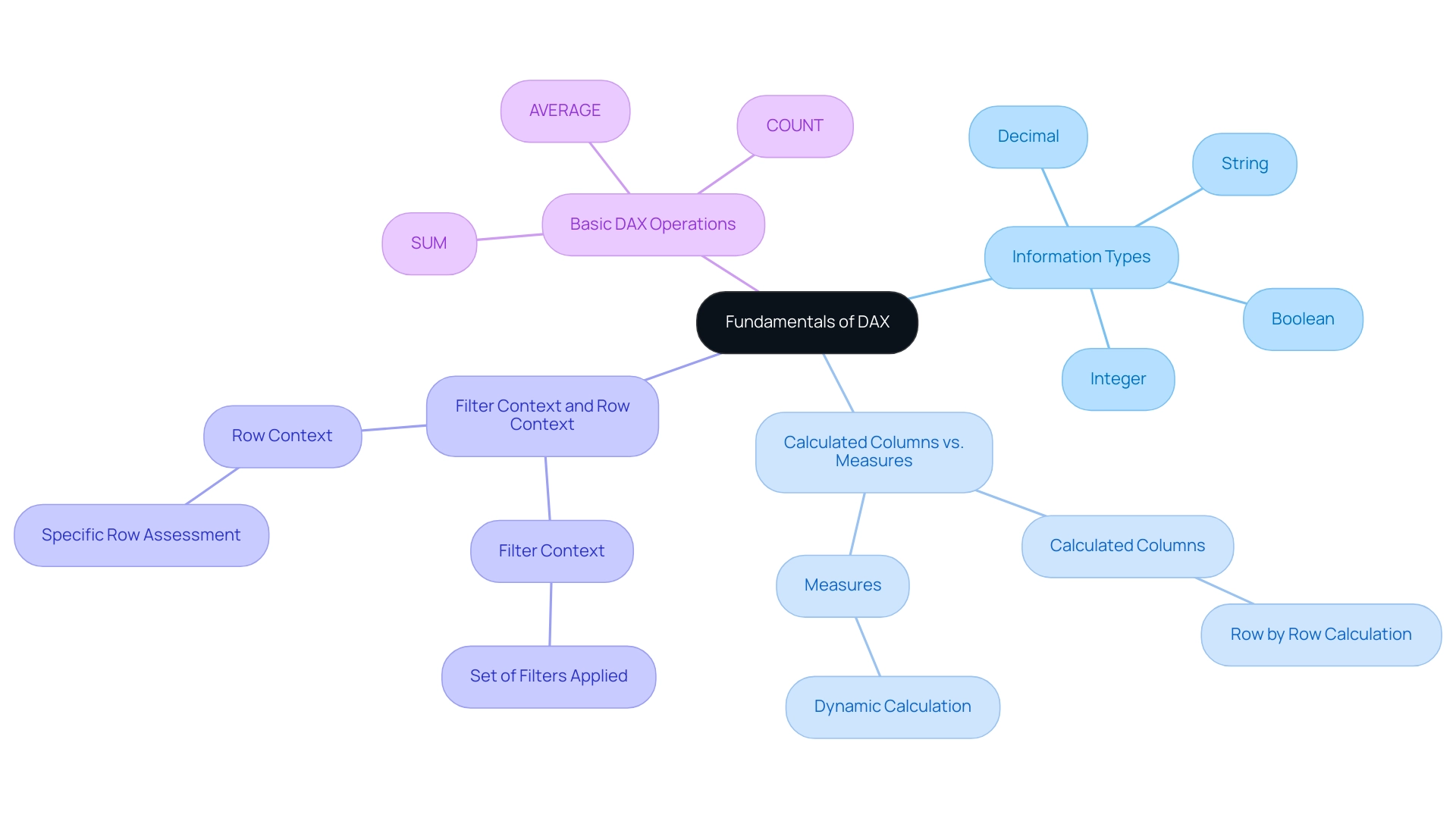
Advanced DAX Techniques for Enhanced Power BI Analysis
Once foundational DAX skills are established, diving into advanced techniques can profoundly enhance your data analysis capabilities in Power BI, aiding in overcoming common challenges such as time-consuming report creation and data inconsistencies. Here are several key techniques to explore, particularly in the context of creating interactive visualizations with tools like Drill Down Network PRO, which allows for extensive customization and automatic relationship detection:
- Using Multiple IF Statements: Master the art of nesting IF statements to create intricate conditional logic. For instance, you can categorize sales performance into distinct tiers based on established thresholds:
DAX
SalesTier = IF(Sales[Amount] > 10000, "High", IF(Sales[Amount] > 5000, "Medium", "Low"))
- Time Intelligence Features: Utilize DAX time intelligence features to perform powerful calculations such as year-to-date totals, comparisons with prior periods, and running totals. Functions like
TOTALYTD,SAMEPERIODLASTYEAR, andDATEDIFFare essential for conducting period-based analyses:
DAX
YTD Sales = TOTALYTD(SUM(Sales[Amount]), Date[Date])
- Using CALCULATE: The
CALCULATEfunction is a transformative tool that enables you to adjust the filter context of your calculations. This is particularly advantageous when applying additional filters or modifying existing ones:
DAX
SalesLastYear = CALCULATE(SUM(Sales[Amount]), SAMEPERIODLASTYEAR(Date[Date]))
- Variables in DAX: Introducing variables can streamline complex expressions and enhance performance. By capturing intermediate results in variables, you can render your DAX code more readable and efficient:
DAX
TotalSales = VAR CurrentSales = SUM(Sales[Amount])
RETURN CurrentSales
By mastering these advanced techniques, you will elevate your analytical capabilities in Power BI, transforming data into actionable insights that drive informed decision-making within your organization. These operations not only simplify complex business scenarios but also facilitate dynamic reporting, a necessity in today’s data-rich environment. Moreover, integrating these DAX techniques with Robotic Process Automation (RPA) can automate reporting processes, further enhancing operational efficiency and reducing the time spent on manual tasks.
Furthermore, Cloud that’s 12 years of experience in training and consulting reinforces the credibility of these techniques, ensuring that you learn from a trusted source. The structured learning context provided in the daxguide course outline for Advanced DAX will further enhance your understanding and application of these techniques in real-world scenarios, equipping you with the necessary skills for advanced data analysis in Power BI. As Jason Himmelstein observed, the ability to use visual calculations in combo charts, such as the line and clustered column chart, exemplifies the evolving capabilities of DAX tools in creating insightful visualizations.
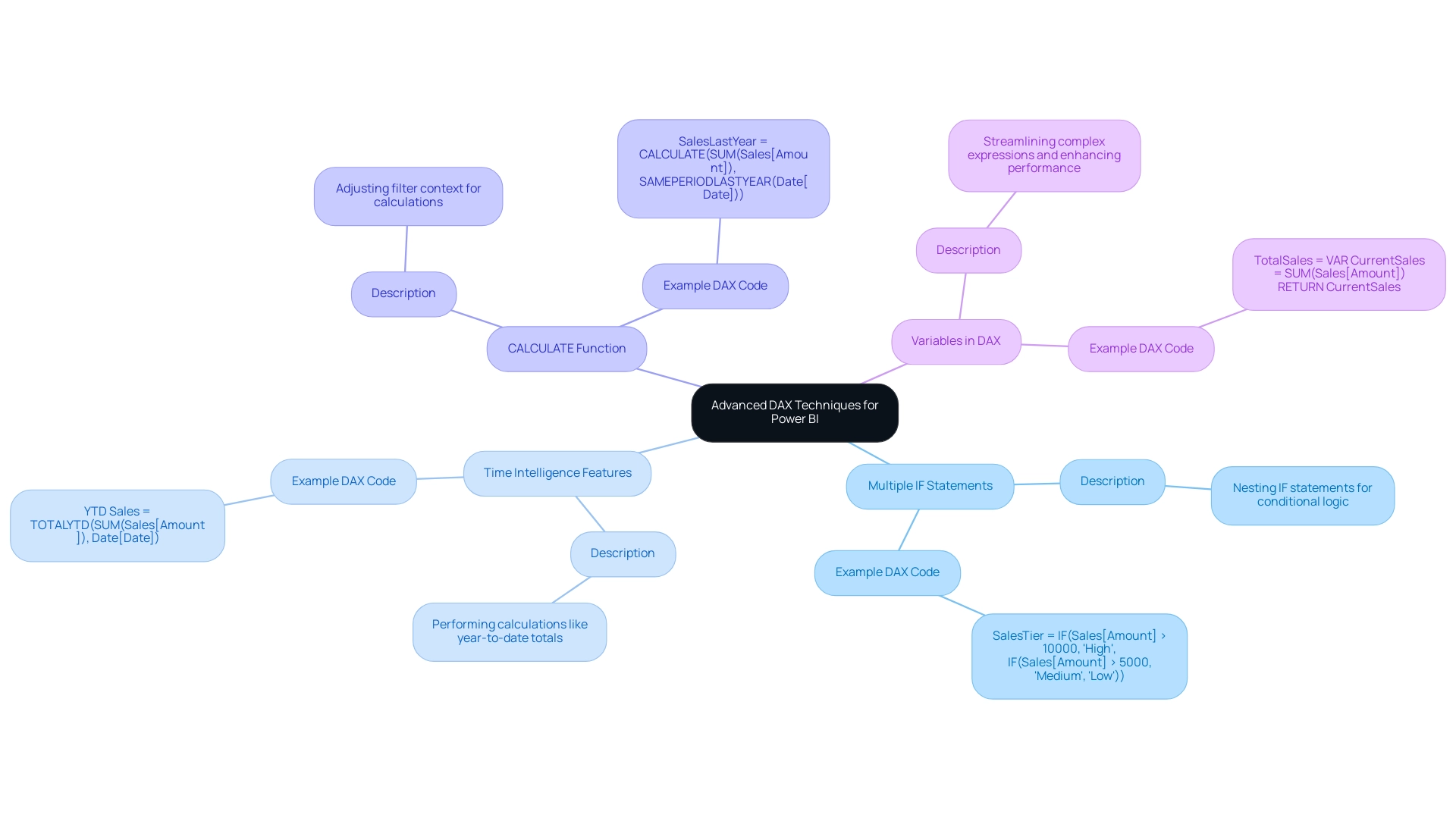
Common DAX Functions and Their Applications
Mastering common DAX expressions, referred to as daxguide, is crucial for executing a wide range of calculations efficiently and leveraging Business Intelligence for operational success. Here are five essential roles to consider for your analytical toolkit:
- SUM: This function aggregates all the values in a specified column, allowing for straightforward total calculations.
DAX
Total Sales = SUM(Sales[Amount]) - AVERAGE: Use this function to determine the mean of values within a column, providing insights into average performance.
DAX
AverageSales = AVERAGE(Sales[Amount]) - COUNTROWS: This function counts the total number of rows in a given table or expression, useful for tracking orders or transactions.
DAX
TotalOrders = COUNTROWS(Sales) - DISTINCT: Employ this function to return a one-column table with unique values from the specified column, assisting in customer segmentation.
DAX
UniqueCustomers = DISTINCT(Sales[CustomerID]) - FILTER: This powerful function generates a filtered table based on specified criteria, allowing for targeted analysis.
DAX
FilteredSales = FILTER(Sales, Sales[Amount] > 5000)
Additionally, the TOTALMTD function is particularly useful for calculating the month-to-date total sales amount, which can be expressed as:
DAX
TotalSalesMTD = TOTALMTD(SUM(Sales[Amount]), 'Calendar'[Date])
This practical application highlights how DAX functions can be employed to derive meaningful insights from your data, streamline report creation, and mitigate data inconsistencies. For instance, using the FILTER tool can help you quickly isolate high-value sales, allowing for faster decision-making and reporting.
Moreover, understanding the distinction between calculated columns and measures is essential in daxguide. Measures are utilized for dynamic calculations based on the present context, while calculated columns are static and computed during loading. This distinction enables analysts to select the suitable approach for their particular analytical requirements in Power BI.
Incorporating RPA solutions alongside DAX operations can further improve operational efficiency. By automating repetitive tasks linked to preparation and reporting, RPA can free up valuable time for analysts, enabling them to concentrate on deriving actionable insights. By merging these functions and concepts into your daxguide arsenal, you enhance your analytical capabilities within Power BI, streamline your analysis processes, and empower yourself to derive actionable insights that drive growth and innovation.
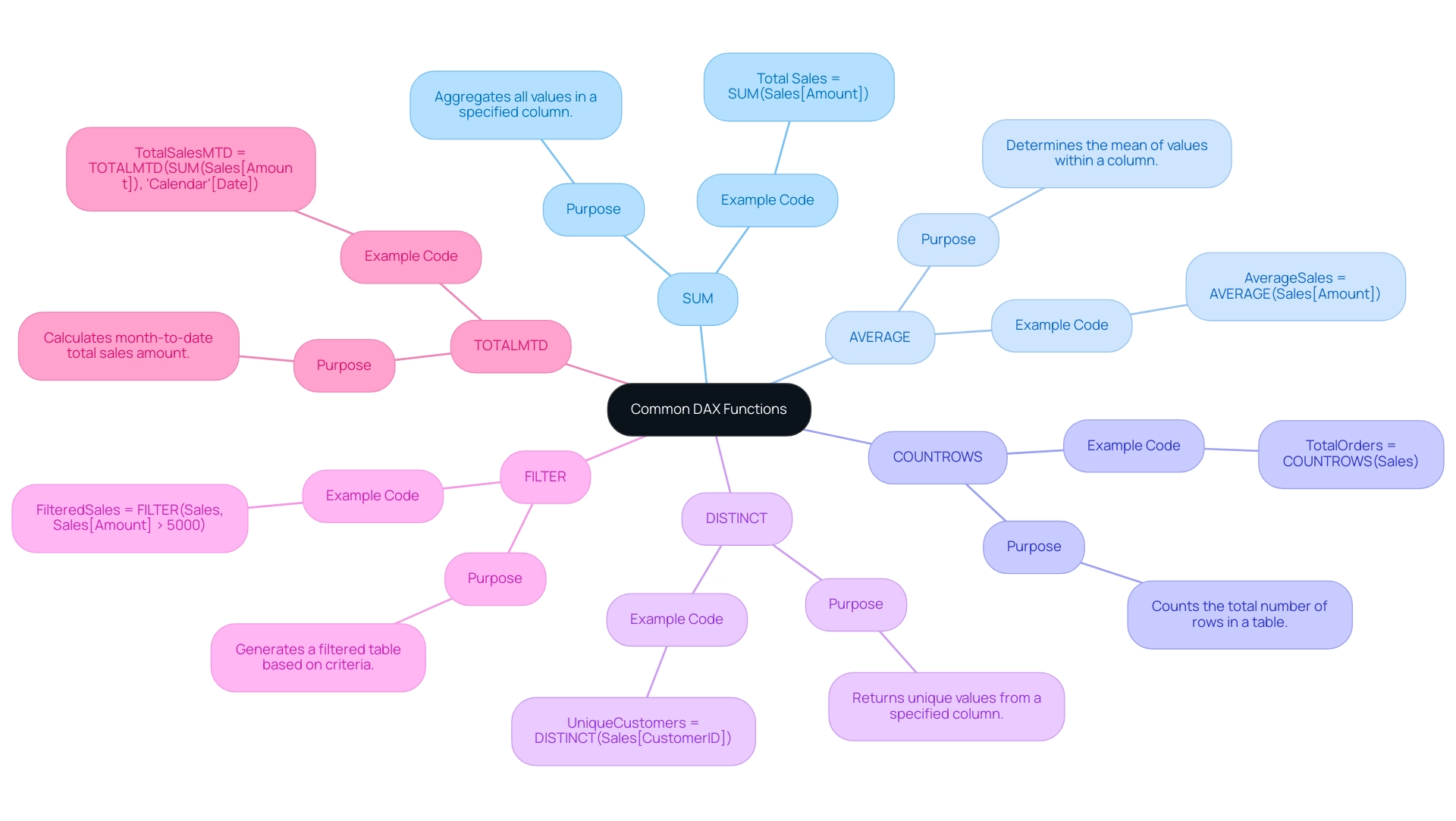
Debugging DAX: Common Errors and Solutions
Troubleshooting DAX formulas can often feel overwhelming, particularly when confronted with challenges such as time-consuming report creation, inconsistencies, and the need for a comprehensive daxguide. By recognizing and understanding common errors, you can streamline the debugging process and enhance your analytical performance. Here are some frequent issues along with their effective solutions, each directly addressing the challenges you may encounter:
- Errors in Syntax: Always ensure that your DAX expressions are formatted correctly, with appropriate parentheses and commas. For instance:
DAX
TotalSales = SUM(Sales[Amount)
Should be corrected to:
DAX
TotalSales = SUM(Sales[Amount])
This attention to syntax can prevent unnecessary delays in report generation.
-
Incorrect Information Types: DAX is particularly sensitive to types. Always confirm that you are using the correct type for your calculations. Executing mathematical operations on text information, for instance, will invariably result in errors, contributing to inconsistencies in your reports.
-
FILTER Function Issues: When using the FILTER function, ensure that your table expressions and conditions are valid. Incorrect conditions can yield unexpected results, so double-check your criteria for accuracy. Tackling this can help offer clearer, actionable insights from your information.
-
Circular References: Circular dependency errors occur when a measure inadvertently refers back to itself. To avoid this, closely review your calculations and eliminate any scenarios that could create such references. This practice supports a more reliable governance strategy in your reporting.
-
Neglecting a Dedicated Date Table: Failing to integrate a dedicated date table can significantly affect time intelligence calculations. This oversight can lead to inaccurate analyses, making it crucial to implement a separate date table in your model. Such integration is essential for generating trustworthy reports that guide decision-making.
By familiarizing yourself with these prevalent errors and their corresponding solutions provided in daxguide, you can significantly enhance your debugging capabilities for DAX formulas, ultimately improving your analytical performance and addressing common challenges in report creation. As Mohan Raju, a results-driven business analyst, aptly stated, “Thank you for sharing, this is helpful!” This sentiment highlights the importance of mastering these concepts to bridge information gaps effectively.
Additionally, the case study titled “Common Mistakes in DAX Usage” illustrates how avoiding mistakes such as incorrect syntax, wrong data types, and circular references can lead to more effective DAX utilization and improved data analysis in Power BI, directly addressing the challenges of report creation and actionable guidance.
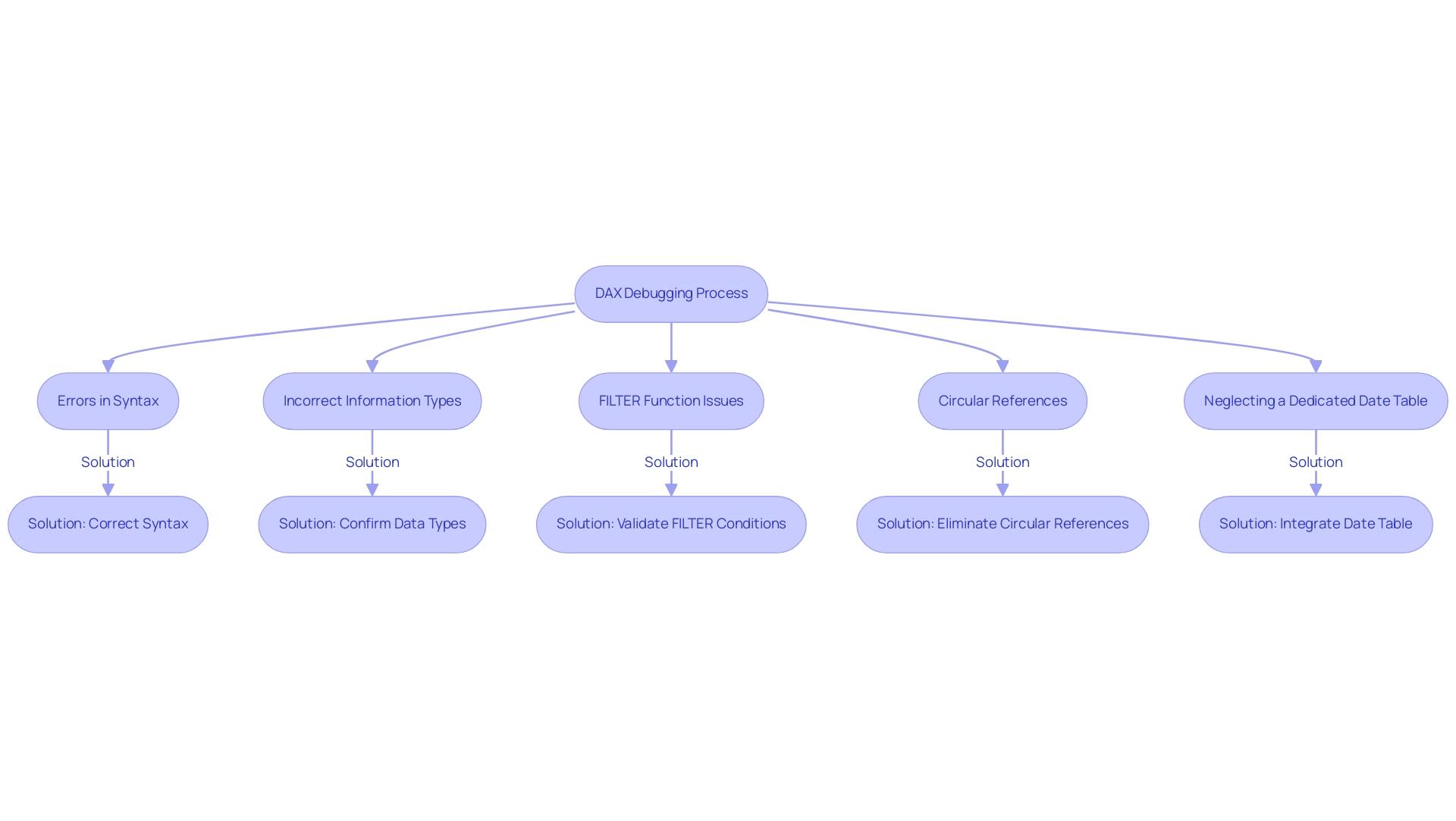
Best Practices for Writing DAX Code
To write effective DAX code, consider the following best practices that can significantly enhance both clarity and performance while supporting your business intelligence goals:
-
Use Clear Naming Conventions: Descriptive names for measures and calculated columns make it easier for both you and others to understand their purpose. For instance, prefer
Total Sales Amountover generic options likeMeasureto convey purpose clearly, aligning with the need for actionable insights. -
Keep Formulas Simple: Break down complex calculations into smaller, manageable components. Utilizing variables to store intermediate results not only simplifies your DAX but also improves readability and debugging efficiency, addressing challenges in report creation.
-
Limit the Use of Nested IFs: Instead of relying on multiple nested IF statements, opt for SWITCH to create cleaner and more comprehensible logic. For example:
DAX
SalesTier = SWITCH(TRUE(),
Sales[Amount] > 10000, "High",
Sales[Amount] > 5000, "Medium",
"Low")
-
Optimize Performance: Mindful coding can enhance performance; limit row-by-row calculations and utilize aggregations when feasible. For iterating over tables, prefer functions like SUMX or AVERAGE to ensure efficiency, crucial for operational efficiency. Additionally, integrating RPA solutions can automate repetitive tasks in your reporting processes, further enhancing performance and reducing manual errors.
-
Document Your Code: Incorporate comments within your DAX formulas to elucidate the logic behind intricate calculations. This practice not only supports future updates but also fosters collaboration among team members, promoting a culture of clarity and efficiency.
By adhering to these best practices outlined in daxguide, you can elevate the quality and maintainability of your DAX code, leading to more efficient analyses that empower your operational decisions. For instance, a recent case study titled Working Upstream for Complex Calculations illustrates how daxguide can be used to create calculated columns or flags in the backend, simplifying complex DAX formulas and significantly boosting performance in Power BI.
Moreover, consider exploring the fully featured 30-day free trial of BI Connector, which can enhance your DAX coding experience without requiring a credit card. As of the last update on 07 Nov, 2024, these tools are continually evolving to support users effectively. Furthermore, as Yana Khare emphasizes, integration and collaboration are key; Power BI’s compatibility with tools like Microsoft Excel, Azure, and SharePoint enhances the overall analytical experience, particularly in the context of using clear naming conventions.
By leveraging both DAX best practices and RPA solutions, you can mitigate data inconsistencies and streamline report creation, ensuring your business intelligence efforts are both effective and efficient.
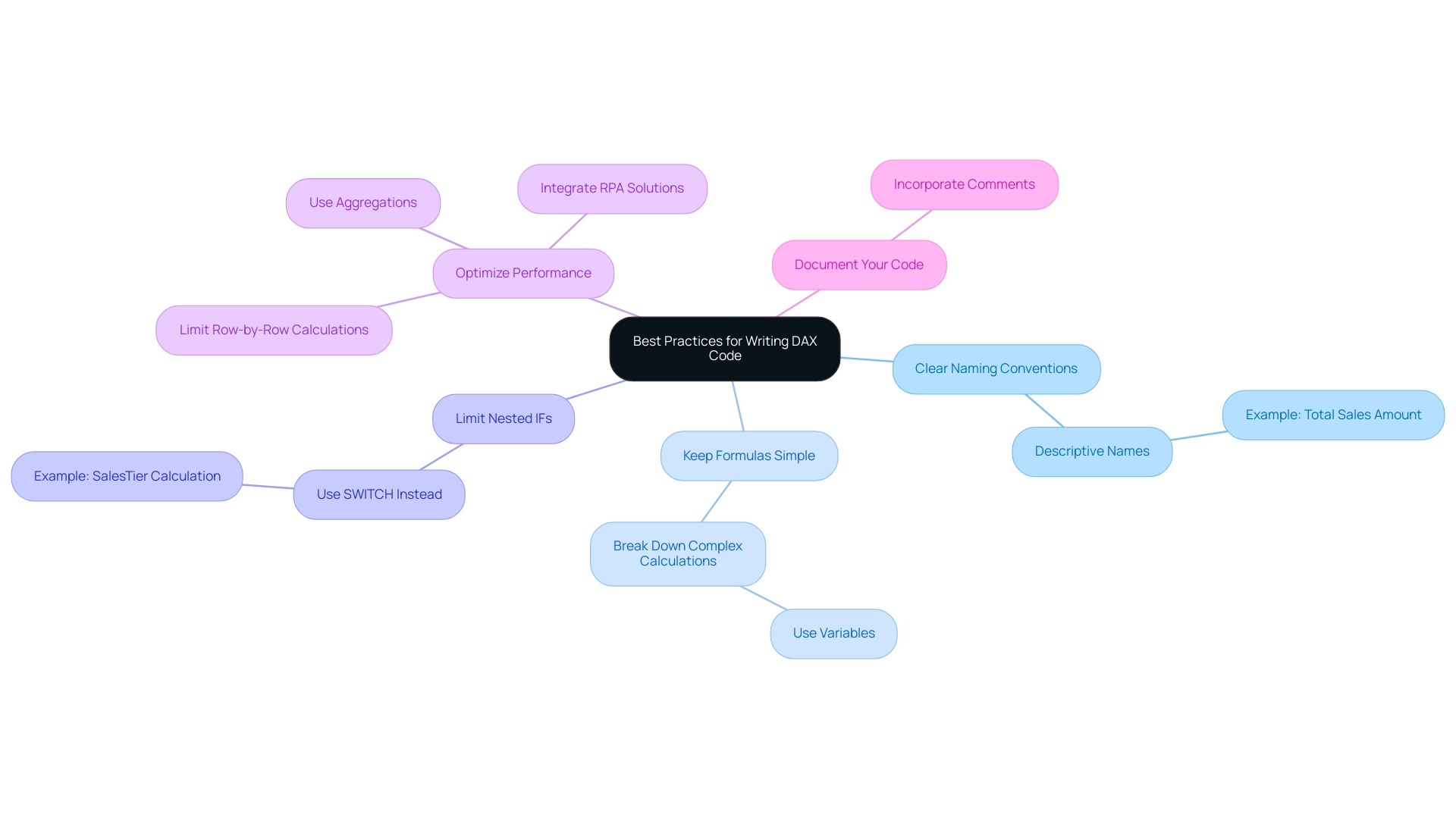
Conclusion
Mastering DAX is not merely an academic exercise; it represents a transformative journey toward enhancing data analysis capabilities within Power BI. By establishing a strong foundation with core concepts such as:
- Data types
- Calculated columns
- Measures
- Basic functions
professionals can confidently navigate the complexities of data manipulation. This foundational knowledge is crucial for driving operational efficiency and informed decision-making in a data-rich environment.
As one delves into advanced techniques, the power of DAX becomes even more pronounced. Utilizing advanced functions and strategies, such as:
- Time intelligence
- The CALCULATE function
significantly enhances analytical capabilities, allowing for deeper insights and streamlined reporting processes. Moreover, integrating best practices in DAX coding ensures clarity and performance, fostering collaboration and minimizing errors in analytical workflows.
Ultimately, the mastery of DAX is a strategic advantage in today’s data-driven landscape. By embracing both foundational and advanced DAX techniques, organizations can transform raw data into actionable insights, driving growth and operational efficiency. The commitment to continuous learning and application of these skills empowers teams to tackle complex data challenges and make informed, strategic decisions that propel their organizations forward in an increasingly competitive market.

